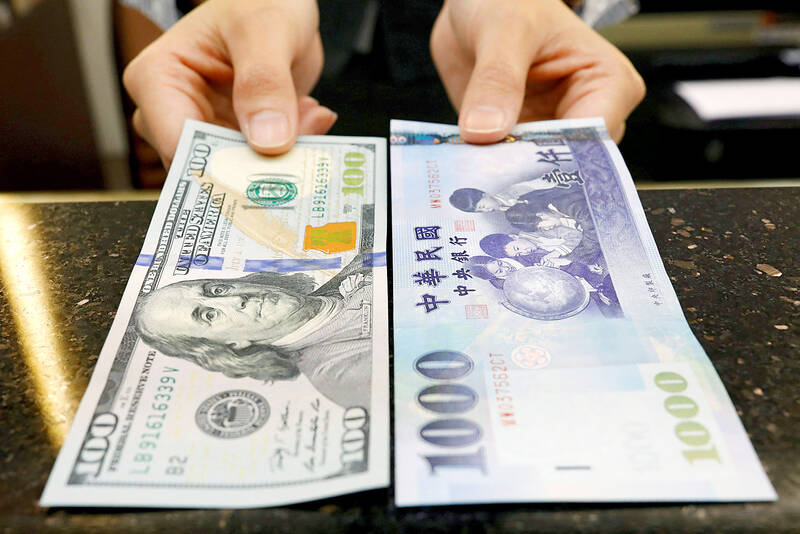Taiwan’s biggest insurers posted a total loss of almost NT$19 billion (US$624 million) last month due to currency volatility after US President Donald Trump warned of a wave of global trade tariffs.
The insurers sustained the worst shortfall in a single month in one-and-a-half years, the Chinese-language Economic Daily News reported.
Among the six biggest, Nan Shan Life Insurance Co (南山人壽) posted the largest loss at NT$9.09 billion. KGI Life Insurance Co (凱基人壽) was the only one among the largest to avoid a hit, reporting a net profit of NT$431 million.

Photo: Tyrone Siu, Reuters
The big shortfalls came even before the New Taiwan dollar’s spike early this month against the greenback, which raised concerns about the industry’s hedging and investment strategies.
Shares of the insurers rose yesterday, buoyed by a broad rally in the region after the US and China agreed to temporarily lower tariffs.
“Taiwan dollar has weakened over the past few days and if that can continue, it can take pressure off their earnings,” Bloomberg Intelligence analyst Steven Lam said.
Insurers are also benefiting from the stock market recovery, with last month’s earnings now backward looking, he said.
Cathay Life Insurance Co (國泰人壽) reported a loss of NT$2.57 billion last month due to higher hedging costs, Cathay Financial Holding Co (國泰金控) said in a statement.
The firm said Trump’s tariff announcement last month exceeded expectations, raising hedging costs.
Fubon Life Insurance Co (富邦人壽) reported a net loss of NT$2.41 billion, citing volatile global financial markets due to US trade policies, while Shin Kong Life Insurance Co (新光人壽) posted a net loss of NT$3.81 billion and Taiwan Life Insurance Co (台灣人壽) had a net loss of NT$1.32 billion last month.
The losses add to evidence that Taiwan’s life insurers might be overexposed and under-hedged relative to their US dollar investments.
The NT dollar rose more than 6 percent in the first two trading days of this month, effectively reducing the value of unhedged US dollar investments, leading the Financial Supervisory Commission to offer assurances on Tuesday last week that no insurers have had solvency issues so far.
The central bank the same day announced it would inspect banks to ensure that fund inflows are for investment, not currency speculation. The NT dollar has since stabilized.
Fubon Life said it has increased its hedging to mitigate the currency effects of NT dollar gains, adding it would closely monitor the market and dynamically adjust its hedging to handle currency risks.
Cathay Life, which had its first monthly loss since last year, said hedging costs rose last month, but the effect is controllable.
Goldman Sachs Group Inc analysts said in a note released on Thursday last week that a 10 percent appreciation of the NT dollar against the greenback could lead to about US$18 billion of unrealized currency losses for local insurers, who hold about US$710 billion of foreign currency assets.
Such a move would wipe out the roughly US$6.6 billion reserves insurers have for currency volatility, Goldman’s analysts wrote.

Mercuries Life Insurance Co (三商美邦人壽) shares surged to a seven-month high this week after local media reported that E.Sun Financial Holding Co (玉山金控) had outbid CTBC Financial Holding Co (中信金控) in the financially strained insurer’s ongoing sale process. Shares of the mid-sized life insurer climbed 5.8 percent this week to NT$6.72, extending a nearly 18 percent rally over the past month, as investors bet on the likelihood of an impending takeover. The final round of bidding closed on Thursday, marking a critical step in the 32-year-old insurer’s search for a buyer after years of struggling to meet capital adequacy requirements. Local media reports

AI BOOST: Although Taiwan’s reliance on Chinese rare earth elements is limited, it could face indirect impacts from supply issues and price volatility, an economist said DBS Bank Ltd (星展銀行) has sharply raised its forecast for Taiwan’s economic growth this year to 5.6 percent, citing stronger-than-expected exports and investment linked to artificial intelligence (AI), as it said that the current momentum could peak soon. The acceleration of the global AI race has fueled a surge in Taiwan’s AI-related capital spending and exports of information and communications technology (ICT) products, which have been key drivers of growth this year. “We have revised our GDP forecast for Taiwan upward to 5.6 percent from 4 percent, an upgrade that mainly reflects stronger-than-expected AI-related exports and investment in the third

TECHNOLOGICAL RIVALRY: The artificial intelligence chip competition among multiple players would likely intensify over the next two years, a Quanta official said Quanta Computer Inc (廣達), which makes servers and laptops on a contract basis, yesterday said its shipments of artificial intelligence (AI) servers powered by Nvidia Corp’s GB300 chips have increased steadily since last month, should surpass those of the GB200 models this quarter. The production of GB300 servers has gone much more smoothly than that of the GB200, with shipments projected to increase sharply next month, Quanta executive vice president Mike Yang (楊麒令) said on the sidelines of a technology forum in Taipei. While orders for GB200 servers gradually decrease, the production transition between the two server models has been

US sports leagues rushed to get in on the multi-billion US dollar bonanza of legalized betting, but the arrest of an National Basketball Association (NBA) coach and player in two sprawling US federal investigations show the potential cost of partnering with the gambling industry. Portland Trail Blazers coach Chauncey Billups, a former Detroit Pistons star and an NBA Hall of Famer, was arrested for his alleged role in rigged illegal poker games that prosecutors say were tied to Mafia crime families. Miami Heat guard Terry Rozier was charged with manipulating his play for the benefit of bettors and former NBA player and